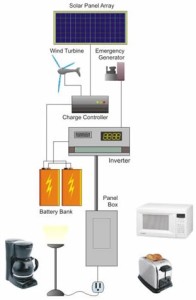Off-Grid or Grid-Tied - What's the Difference?
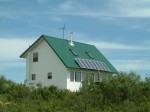
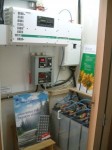
"I want to go off-grid and use solar instead of bringing in SaskPower!" The desire for independance prompts many a call to Suncatcher Solar from people who want to be self sufficient and hope that solar power holds the answer to that dream. But what does that really mean? What's the difference between "off-grid" and "grid-tied" and what kind of lifestyle does each one entail? What Does it Mean to Go Off-Grid? Going off -grid means going it on your own. You have to produce and store all your own power and if you run out you start up the backup generator. There is no power utility to fall back on. On the other hand, neither is there a power bill.
Off-Grid Solar and Wind Power System
An off-grid system needs a storage system for the electricity that you produce so that it will be available for times when there is no source of electricity. This storage system is one of the main features that distinguish an off-grid system from a grid-tied system. The other is a backup generator for long periods of cloud or calm. The figure at the right shows the basic components for an off-grid system. A solar array and an optional wind turbine provide electricity to run the appliances in your home. Whatever you don't need immediately is stored in the battery bank. Since you are completely reliant on your own resources the battery bank must be large enough to see you through at least 3 days without any solar or wind charging. This typically means very large battery cells forming a bank that requires a space that is a minimum of 2' wide by 4' long and 3' high.
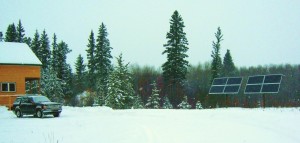
Remote Solar Power System
You will need to plan your energy use using a load analysis so that the charging system and battery bank is large enough to meet your needs. Heating your home in a cold climate will present some challenges. Some heating systems are difficult or prohibitively expensive to operate with an off-grid system. For example, you cannot run a geothermal system with off-grid power - the power requirements for the pumps are too large. Passive solar design and an in floor heating system are usually the best options for off-grid systems.
What is a Grid-tied Solar Power System?
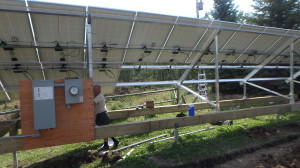
Grid-tied Solar Power System
A grid-tied system is connected to your electrical utility company's power "grid". The utility is now your backup generator. There is a basic monthly cost for a grid connection (usually around $25) but this is much less expensive than the $6000 or more for a generator and the fuel that the generator uses. You can see the utility meter and subpanel for the large solar array shown in the photo on the right.
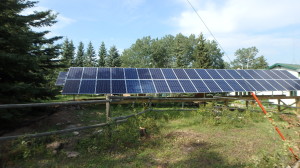
Grid-tied Solar Array
A grid-tied system often includes a net metering agreement. This means that when you produce extra power you can feed it back to the grid and receive a credit on your power bills for those times when you use more than you produce. Some utility companies may also pay you for your excess power, or buy power from you at higher than the going rate (this is called a Feed-In Tariff ).
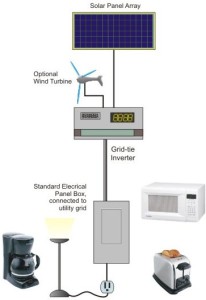
Grid-tied Solar and Wind Power System
The grid now also becomes, in a sense, your battery bank. Because you feed back your excess power for a credit, it is effectively "stored" for you until you need it. Usually this means that you feed back extra power in the summer and then use the credits in the winter when you need the power for your heating system. This is much less expensive than buying and maintaining a battery bank. Looking at the figure on the left you can see that the grid-tied system is the same as the off-grid system but without the battery bank and its charge controller and without the emergency generator.
A Cost Comparison
This means that it is much less expensive to set up and maintain a grid-tied system. It also means that most of your money is going to what you really wanted to buy in the first place - solar and/or wind power. The inverter system, which converts the DC solar power to normal household AC power, is the only other expense for materials. Installation is also less expensive if there is no battery bank, charge controller and generator to install. This typically makes a residential grid-tied system at least $15,000 less than an off-grid system. So why would you want to invest in an off-grid system? Off-grid systems are still cost competitive if you live sufficiently far from the closest grid connection. If you need to have power brought in it may cost you at least as much or more to connect to the grid as to pay for the batteries and generator required for an off-grid system. If it will cost you $20,000 or more to bring in power, for example, the off-grid system quickly pays for itself, especially since there will be no ongoing power bills.
A Benefits Comparison Off-grid System Pros and Cons:
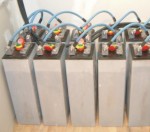
Off-grid Battery Bank
Pros:
- ideal for more remote situations where power is expensive to bring in. - no power bills. - no power outages. - self sufficiency on a clean, renewable energy source.
Cons:- batteries and generator are expensive and require maintenance. - lifetime for the batteries and generator(10 - 15 years) is less than for the solar array (35 years) and wind turbine (20-25 years). - no seasonal storage. Batteries can only store power for a few days and have a maximum capacity. When they are full, the rest of the power is wasted unless you can find an immediate use for it. - power use must be carefully planned.
Grid-tied System Pros and Cons: Pros:- easy backup from grid power. - eliminates need for expensive batteries and generator (which also requires fuel). - provides seasonal storage if a net metering or Feed-in Tariff program is available. - maintenance free for a solar power system (wind requires some maintenance and repair). - internet monitoring available with inverters designed to be used for individual solar panels (Example). - you are providing clean energy to the grid.
Cons:- power outages. When utility power goes out your system also goes out unless you invest in a battery bank. This is a requirement by the utility company and is for the safety of those repairing the system. - you still have to pay the basic utility bill, just not for whatever power you've produced. - you are still using non-renewable resources when there is no solar or wind.
Making the Choice
Choosing the power system that's right for you depends on your building site and the lifestyle that you prefer to live. Contact us and discuss the options with us.
